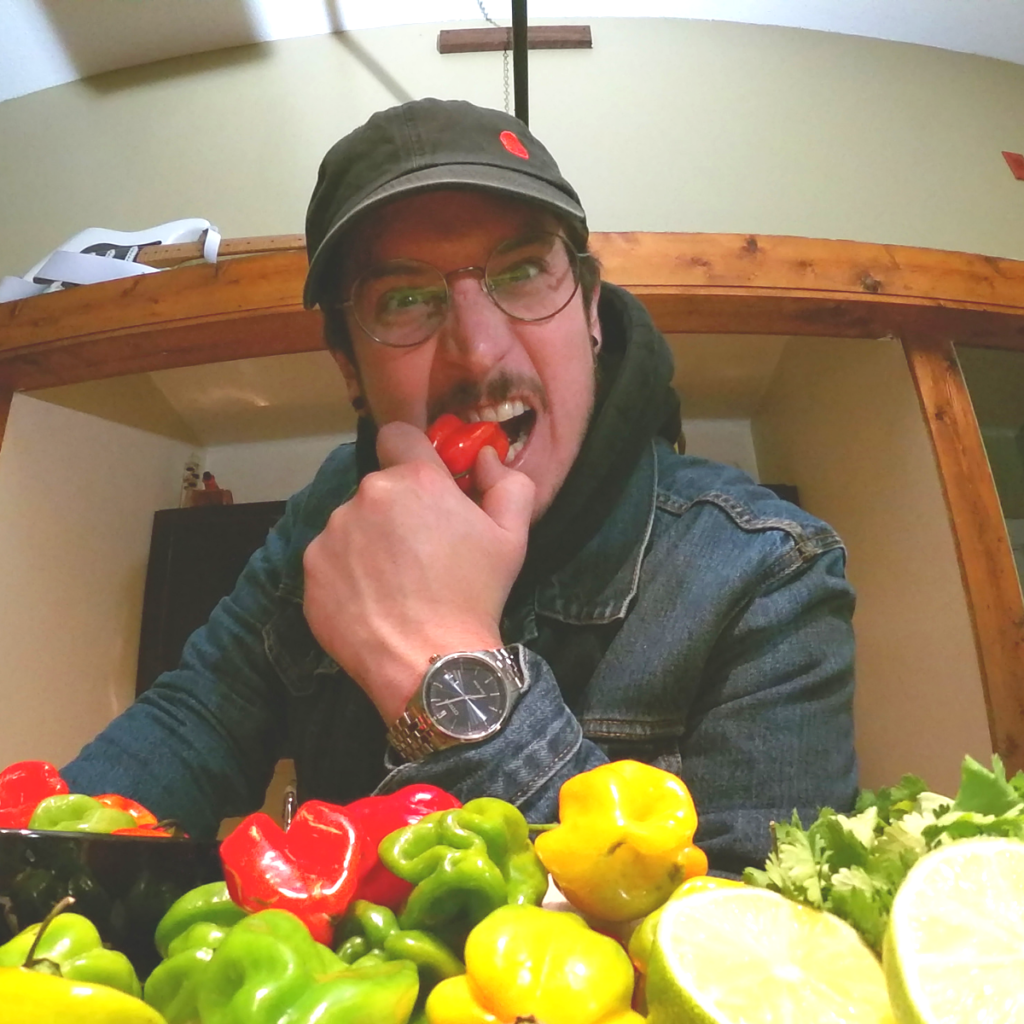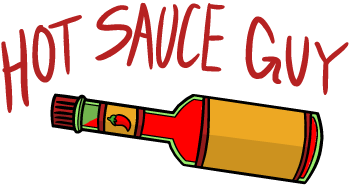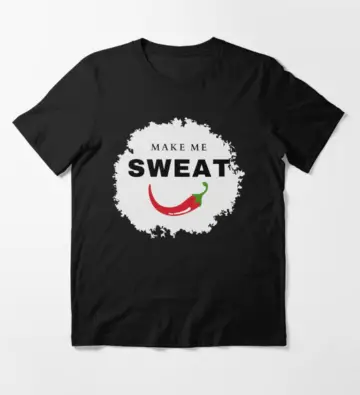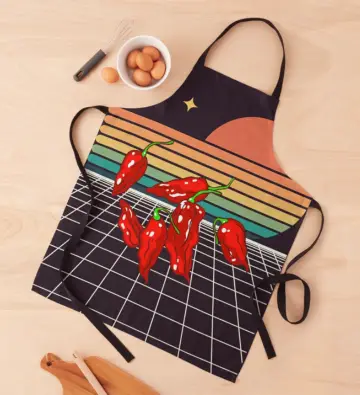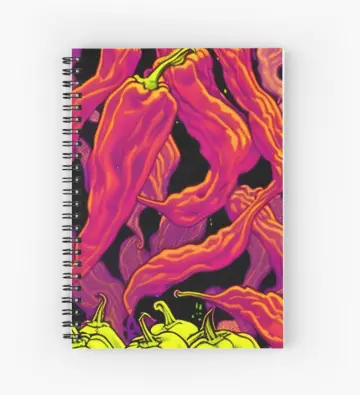Learning how to grow peppers indoors can be quite challenging, especially when growing super-hots. Hot pepper plants need lots of sunlight and warm temperatures. If you want to grow pepper plants indoors, you’ll need to recreate this environment so the plant will flourish.
Thankfully, there are 5 main points you need to keep in mind when growing hot peppers indoors.
- Container Size and Soil
- Lighting
- Watering
- Temperature and Humidity
- Nutrients
In this article, we’ll also talk about the tools and items you should have as well as some tips on dealing with pests and disease.
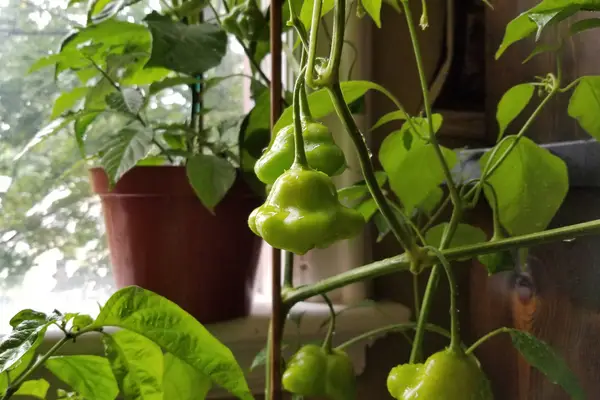
What You Need To Grow Peppers Indoors
Before we get started, there are a few items you’ll need to help you along your indoor growing journey.
You’ll need a few containers for your pepper plants to call home. A germination tray for the early stages, a mid-sized pot for the seedling phase, and a larger 1-5 gallon pot for the final stages of your hot pepper plants’ growth.
Then, some soil to put inside your pepper plant containers. You’ll want to plant your peppers in good nutrient-rich soil that also drains well. Don’t use soil from an outside garden, you might bring in unwanted pests. Look for something nutrient-rich and pH adjusted for best results.
If you really want your indoor pepper grows to produce, you’ll want to put them under grow lights. Pepper plants need 14-16 hours of light per day and grow lights on a timer is the most effective solution indoors. Look for a grow light that is energy efficient and dimmable. The dimmer allows you to control the intensity of the light without moving the light up or down.
Fertilizer, or nutrients, is the food your plants need to produce ripe and tasty peppers. These fertilizers will contain Nitrogen, Phosphate, and Potash, as well as other nutrients like Calcium. You can either buy one all-purpose fertilizer like Promix Organic Vegetable Fertilizer, or you can use different fertilizers for each stage of growth.
Optional Items
Some option pieces of equipment can help you grow even furth but are not required for growing peppers.
A heating mat can help your seeds germinate faster and can also heat your pepper pots during the seedling stage.
This goes for growing peppers outdoors as well, but if you want to save your back, invest in a table or some sort of shelf to sit your pepper pots on. This way you won’t have to bend over to inspect and harvest your pepper plants.
If you really want to splurge, you can grow your peppers inside a grow tent. A grow tent is essentially a tent for your peppers to live in while they grow. These can be handy if you are short on real estate and need to occupy your grow space. The downside to grow tents (or upside?) is that fans and airflow systems become a necessity for growing good peppers, so you’ll need to invest in those as well.
Setting Up Your Indoor Grow Room/Environment
You’re going to need to decide where to grow your plants. There are a few options for you
- In front of a window
- In a grow room
- In a smart garden
If you lived in an apartment like me, sometimes the best place to grow over the winter is right in front of the window. While this way won’t yield the best results, it is cost-effective and very easy. All you really need to do is water and feed the plant, the sun takes care of the lighting.
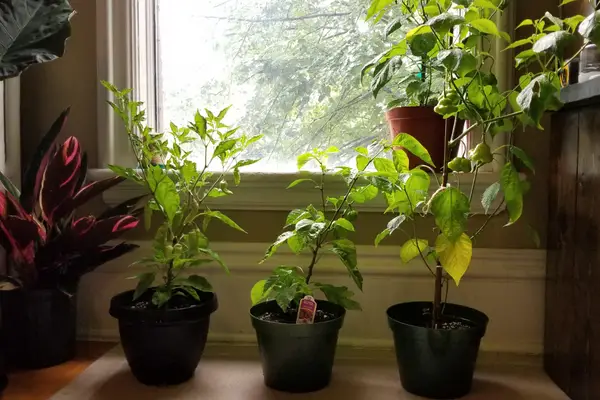
Growing in a grow room is the best way to control your growing to produce as many pods as possible. A dedicated room means you can set the temperature, humidity, and lighting schedule to cater to your plants. This allows you to create the perfect environment for growing hot peppers. Growing this way can use up a lot of electricity and makes for a bigger bill at the end of the month.
It is possible to grow hot peppers in a smart garden like Click & Grow. If you have the space you can grow these right on your countertop. The plants may not get super huge but the system is easy to water and has built-in lighting so much of the hard work is done already.
Once you have your growing environment set up, it’s time to start growing. But first, we need to decide what we’re going to grow.
Choosing a Variety of Pepper to Grow Indoors
Not all pepper varieties are created equal and some are easier to grow indoors than others. For example, super-hot pepper varieties require warm temperatures which can be more difficult to create indoors.
Plant size matters as well, Baccatum plants tend to grow much larger while the Chinense variety tends to grow a little short and stout.
Using a smaller container can also help limit the size of the plant. A small container will constrain the root system and stunt the growth of the plant.
You might also want to select a pepper variety that produces smaller pods. These types of plants tend to produce more pods indoors. A larger pepper like Bell or Poblano may only produce 1-3 peppers indoors.
If you’re growing from seed you’ll want to make sure you are getting seed from a quality provider. We reviewed a bunch of online Canadian seed retailers and created a database to help you choose the right one. Here are the 10 Best Places To Buy Hot Pepper Seeds Online In Canada.
How To Start Your Pepper Plants Indoors
When you grow peppers indoors, there are a few ways you can start the journey.
From Seed
When you grow peppers indoors, you could start your plants from seeds. In this case, germinate your seeds in a tray using a seed-starting soil mix. Moisten the soil and pack it into each pod. Don’t pack too tight, otherwise, the roots may have a harder time moving through the soil.
Place your seed in the pod about 1/4″ below the surface and cover the seed. Mist with water to settle the soil around the seed.
If you have a heating mat, put the germination tray on the mat to heat up. The heat will speed up the germination process. Once the seedling has sprouted two sets of true leaves it is ready to transplant.
Transplanting A Seedling
The second way to start your peppers indoors is to purchase a seedling from a garden center or friend. One of the benefits to getting seedlings is that you don’t have to wait for seeds to germinate and you don’t require seed trays and heating mats.
You can also find some pretty interesting varieties of peppers if you have a grower nearby.
Bringing Outdoor Plants Indoors
This isn’t always the best idea, but if you have a plant outdoors that you absolutely want to bring inside, you can dig it up and pot it.
You should wait until the evening to cut the rootball out of the ground, lower temperatures will cause less stress on the plant.
With the plant out of the ground, it’s time to clean out the root system. Bugs will hide out in the root system and lay eggs, so cleaning the roots will remove these pests. Use a hose to spray the rootball until the soil has all washed away.
Put the plant in a pot and add clean fresh potting soil. Start by putting some soil at the bottom of the container, then introduce the rootball to the container. Fill the rest of the container with soil while shaking the plant lightly. This will help the soil settle in between the roots.
How To Grow Peppers Indoors
Now comes the fun part!
At this point, you either have a growing plant, or a seedling ready to be transplanted. Here is what you need to do to turn your plants into pepper-producing machines.
1. Container Size and Soil
Container size and soil can have quite an impact on the results of your indoor pepper grow.
For example, too small of a container and your plants become root bound and may produce smaller peppers and a low yield. If your pot is too big, you might end up with a pepper plant so large it won’t fit in your grow space.
In some cases, you may want to use a smaller pot with a pepper variety that tends to grow larger. Bishops Crown plants for example grow quite large and can be contained by using a smaller pot.
For your seedlings, you can use a 1-gallon pot, this should give the plant enough room to start spreading its roots. Once your plant is starting to get taller and a little thicker, you can move it to a large pot for some mega-growth.
A 3 or 5 gallon will be plenty big for growing big, bushy, and bountiful pepper plants.
No matter which stage of growth you’re at, the container you are using should have adequate drainage. This keeps the roots from sitting in a wet environment which can lead to root rot.
Soil
When it comes to soil, you’ll want to use fresh organic potting soil made for vegetable growing. You can use the vegetable mix soil from your local department store. You can also use the really fancy stuff from a grow shop. Both work well in tandem with nutrients.
It is not advisable to use dirt from your garden, no matter how much you love it. The soil from your garden can be riddled with pests, eggs, fungus, you name it. You don’t want to be introducing that stuff to your indoor grows.
If you absolutely must use garden soil then you should flush it with boiling water before using it. This should kill most bugs, eggs, and fungus so they don’t become pests in your grow room.
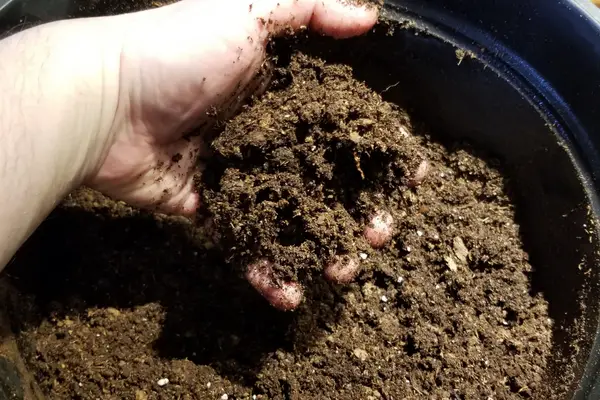
2. Lighting
For bigger plants and larger yields, you will definitely need to get your lighting right. Pepper plants are used to a lot of sunlight so you’ll need to set up a lighting system with a timer. For best results, give your plants 12 to 16 hours of light every day.
Indoor pepper grow plants will also need some nighttime too. This gives them a break from growing and producing all day. It also gives your electricity bill a break.
Try to use an actual grow light, something that puts out quite a few lumens. LED lights work fine and you can find many on Amazon or at your local grow shop.
Stronger light means better growth and more fruits. But too much light can also lead to leaf curling. To combat this, you can adjust the intensity of your lighting.
Some lights come with an intensity control to allow you to fine-tune the amount of light hitting your plants. If your light doesn’t have a dimmer, then you can just raise them higher or lower to adjust the intensity of the light.
An added bonus would be to find a light that is silent. My very first indoor grow ended up keeping me up most nights. Those fans can get pretty loud when you grow peppers indoors.
3. Watering
How do I know when to water my plants? This is probably the first thing you think of when learning how to grow peppers indoors.
Watering your pepper plants might sound tough, but it’s actually really easy. When plants are indoors away from the elements, they tend to retain moisture longer. This means you won’t need to water your indoor peppers very often.
To see if your plant is thirsty, just stick a finger into the soil to see how moist it is. If the soil is still moist when you’re up to your knuckle, then you don’t need to water just yet. If the soil is completely dry when you’re in this far, then you’ll definitely need to water your pepper plant.
Make sure to keep an eye on the leaves as well. You can tell if a plant is thirsty usually by looking at the leaves. Green and droopy leaves are a sign of underwatering as the leaves are wilting. Yellow and droopy leaves are a sign of overwatering.
4. Temperature and Humidity
Hot pepper plants thrive when they’re growing in the right environment. For hot peppers, the optimal temperature is between 21C(70F) and 27C(80F). This is perfect as most homes are kept around the lower end of this range. But, if you’re one of those wild people who love their homes warmer, then you’re peppers will grow even better.
If you really want to recreate the outdoor environment, you should provide the pepper with a warmer light-time and a cooler dark-time temperature to simulate day and night.
Your house might be more on the cooler side. In this case, you’ll need to warm the peppers up. One way to do this is with grow lights. Lowering the lights will increase the temperature under the light as the peppers are closer. Be sure not to bring the lights too close as you may burn the plant.
You could also use a heat mat under the container to warm up the root system.
The ideal humidity for most types of peppers is 70%. Some varieties like lower humidity and some varieties like higher humidity.
Some homes can become pretty dry during the cooler months with the indoor heating on. If you need to adjust your humidity, get either a humidifier or a dehumidifier.
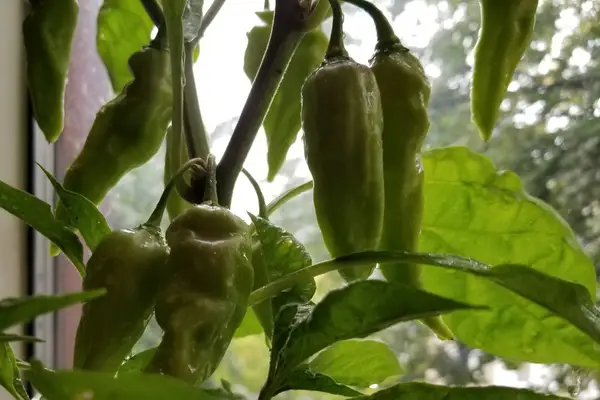
5. Nutrients
When you grow peppers indoors, fertilizing your indoor pepper plants is important as there is a limited number of nutrients in the container soil. By the time your peppers start fruiting, there may not be enough nutrients left in the soil. This causes deficiencies like Blossom End Rot.
Adding nutrients helps your indoor pepper plants grow big and strong.
There are two schools of thought when it comes to fertilizing your hot pepper plants. Either you use one all-purpose fertilizer like Miracle-Gro or Promix. Or, you use a 2 or 3-part fertilizer system to boost growth through all stages of the plant’s life.
During the growth stage of a pepper plant, after the first true leaves have popped up, your plant will need a lot of Nitrogen. Nitrogen promotes photosynthesis and is essential for leaf growth. Providing your plant with Nitrogen during growth will help it grow fast and strong.
When the plant is flowering and fruiting begins, you’ll want to lower the amount of nitrogen. While fruiting, your pepper plants will require more phosphates and potassium.
Using an all-purpose fertilizer provides the plant with the same amount of nutrients during both stages. Using a 2 or 3-part fertilizer system provides a balance of nutrients depending on the growth stage.
Calcium is also beneficial for the fruiting stage of a pepper plant. It helps the cells of leaves and pepper pods develop. You can add bone meal to boost calcium if you need to.
The schedule depends on the fertilizer you are using. The packaging should tell you if it is a weekly or bi-weekly fertilizer.
One more tip, if you plant your peppers in a nutrient-rich soil, wait a couple of weeks before you begin to add fertilizer. This will give the plants time to deplete the nutrients from the soil.
Harvesting Your Indoor Peppers
Harvesting your indoor peppers is a breeze. But there are a few things you should know in order to ensure a maximum harvest.
You’ll know your indoor peppers are ready to harvest when they reach their final colour. This won’t always be red, so check the seed packaging to see what colour your pepper should be.
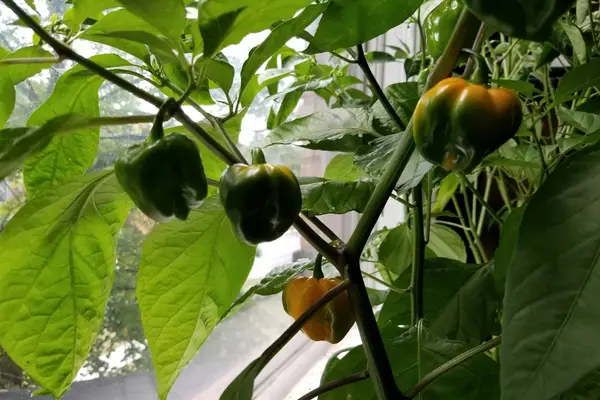
Leaving a ripe pepper on the plant long enough will soften the skin of the pepper. When peppers first turn their color, they are usually a little crunchy. After they have matured a bit more their skin will soften.
When it comes time to pick your peppers from the plant you can either pluck them or snip them. If the pepper is large, then the stem is likely thicker and would require scissors. Small peppers like Thai chilies can be plucked from the plant with a pinch.
If you want to save the seeds from your pepper pods, you’ll need to give the seeds plenty of time to mature on the plant. Once the skin of the pods is thin and slightly wrinkly, you can pluck these peppers.
Pests and Diseases
Sure, there are fewer bugs in your house than there are outside. That doesn’t mean they won’t find your plants. Bugs and diseases can still find their way indoors to your hot pepper plants.
Pepper Plant Pests
Aphids and other bugs can still find their way to your pepper plants when indoors. One cause of this may be contaminated soil from outside.
Most soil you bring in from outdoors will have bugs or bug eggs in the soil. Even some fresh bagged soil can have pests if it was stored outside. It is best to not use soil from outside.
If you do find bugs on your plants you can usually spray them off with water or a mixture of water and dish soap.
Indoor Pepper Plant Diseases
Plant disease can be hard to manage indoors. Especially with high humidity and low airflow.
Some issues you want to look out for are Root Rot, Blosson End Rot, and Light Burn.
Root Rot is a result of overwatering the plant or poor drainage. If the soil is too wet and has nowhere to drain then the roots can actually begin to rot. Obviously, this is not good, so make sure to give your container plenty of drainage and only water when necessary.
Because there is a limited amount of soil in your indoor containers, the plant may run low on nutrients. When the plant is not getting enough calcium you might end up with Blossom End Rot. Blossom End Rot basically rots the tip of the pepper while it is still on the plant, rendering it useless. This is why using fertilizer is important when growing indoors.
Light Burn can happen when your light source is too close to the pepper plant. When the grow light is close, the light is more intense and hotter. This can cause burning on your leaves. If the leaves on your plant are curling, this is a sign that there is too much light.
Time To Grow Peppers Indoors
In conclusion, to grow peppers indoors is a great activity to go through. It can be fun and can help you save money, as well as give you access to different types of peppers that may not be available in your area.
Growing peppers is easy to do, remember to keep the temperature and light source at the right levels, and you will have no trouble growing what you want. If your plants start to wilt or die off, this could mean a variety of problems that need addressing.
It’s all part of the journey, so what are you waiting for?
Mike P
Welcome to The Hot Sauce Guy! I’m Mike, your guide to the spicy world of hot sauces and the creator of Spicy Riffs Hot Sauce. From Canada, I share the hottest reviews, pepper-growing tips, and sauce recipes with a touch of rock and roll.
My passion? Crafting the perfect blend of heat and flavor. Whether you’re here for the fire or the flair, get ready for a journey into the world of spicy delights.
Let’s turn up the heat together!
About Us
